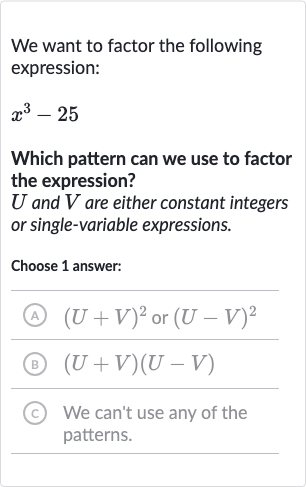AI tutor
Welcome to Bytelearn!
Let’s check out your problem:

We want to factor the following expression:Which pattern can we use to factor the expression? and are either constant integers or single-variable expressions.Choose answer:(A) or (B) (C) We can't use any of the patterns.
Full solution
Q. We want to factor the following expression:Which pattern can we use to factor the expression? and are either constant integers or single-variable expressions.Choose answer:(A) or (B) (C) We can't use any of the patterns.
- Recognize expression type: We need to recognize the type of expression we are dealing with. The expression is a difference of two cubes because is a cube of and is a cube of . The difference of two cubes can be factored using the formula , where and are any expressions. In our case, and .
- Apply difference of cubes formula: Now we apply the difference of cubes formula to the expression . We have and , so the factored form will be .
- Check factored form: We can check our work by expanding the factored form to see if it equals the original expression. . Simplifying this, we get , which is not equal to the original expression . This indicates that we made a mistake in our calculation.
